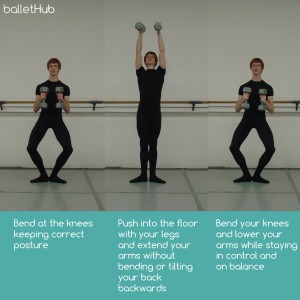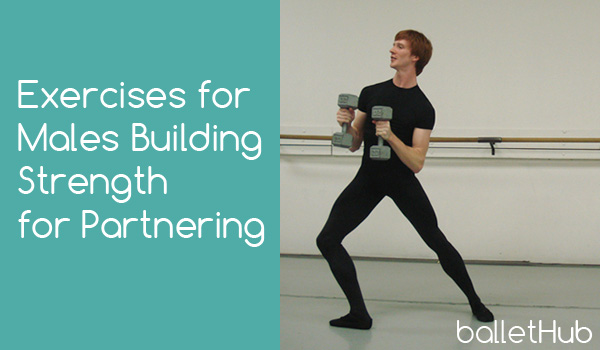For the male in ballet, partnering requires a fair amount of strength. While partnering is not fully based on how big your muscles are, it certainly helps to have a strong core and upper body.
You can of course, always hit the gym. But most exercises one could do at a typical gym would require you to stay stationary and do not always help the dancer know how to apply strength to partnering. What good is a lot of strength and muscle, if you don’t have the coordination?
In this ballet tip for partnering, we’ll look at some ways that a male dancer can improve his strength, coordination, and understanding of how to use strength in partnering.
For these exercises you will need: a studio with plenty of space for you to comfortably lift, a pair of dumbbells that are about 50% of what you can normally carry(so nothing too heavy). Throughout these exercises, as well as any weight lifting, use caution and do not attempt them without supervision! BalletHub is not held responsible for anyone injuring themselves. Do these exercises at your own risk!
Exercise #1: Up and Down Lift
Here we have Kevin Wilson demonstrating a lift, only he’s using dumbbell weights. While he is staying stationary, the idea of this exercise is that not only is he lifting properly but he is also staying aware of a balletic position. You will very unlikely see someone at the local gym lifting with turned out feet and straight legs, but its expected of a male ballet dancer.
Try this exercise with the counts and steps provided:
- Count 1: Holding a set of dumbbells vertically, start standing with straight legs with your elbows a couple inches from your side with your forearms extended front. This is mimicking holding a girls waist before you lift her. Keep your focus straight front as if you are looking at the back of your partner’s neck.

- Count 2: Keep your back straight and bend at the knees in a comfortable first position, just halfway between parallel and full turn out with the feet.
- Count 3: In one motion, push with your legs into the floor and push up with the weights, keeping them vertical.
- Count 4, 5, 6: Your focus will move slightly up with a small tilt back of the neck, not your back. Your back should never tilt or bend backwards when lifting or partnering. Your legs should be straight, still in the comfortable first position, as you hold the weights for a couple counts.
- Count 7,8: Lower the weights down by both bending your knees and lowering your arms back to the start position.
Exercise #2: Traveling Lift
Again Kevin demonstrates how you can use some weights to practice partnering while building strength that can be applied to ballet. In this exercise, he is going through what would be a travelling lift with his partner. This one won’t have counts, but concentrate more on the positions he is making.
- Start in Tendu front, holding your dumbbells vertically about waist high.
- Take one step with a turned out front keeping the weights in the same position. Try to feel the weight mostly on the front leg, but still maintaining balance with the back.

- Push into the floor with your legs and take a step forward while extending your arms high. Your head does not tilt much because you want to focus on where you’ll be walking. Be sure to keep your back forward, not tilting backwards.
- Take two more steps maintaining your position in your back, arms, and feeling the floor as you push for each step.
- Finish by slowly lowering the weights back to the starting position right down the front of you chest, finishing in a turned out fourth position. Be sure to keep a presented chest and strong grip on the floor with your legs.
What to Take Away From These Exercises
You may be thinking, what’s the point of doing this when you can just work out at the gym? And the answer is simply that this allows you to concentrate on how you, as the male partner, are looking during a pas de deux, while not thinking about your position, but also having resistance with the weights to gain strength.
While you should concentrate on your positions in these exercises, of course when it comes to rehearsal or a performance and it means breaking a position to help your partner, a male partner always should. But, when things are going smoothly, you also need to look like a ballet dancer using ballet technique behind your partner and these exercises can help you get there when your partner isn’t available!

